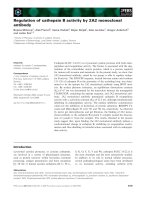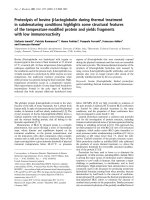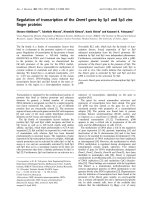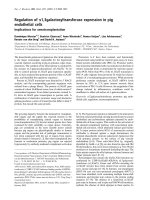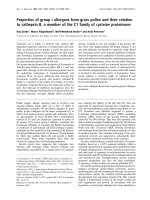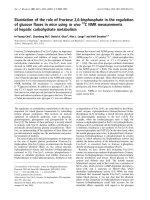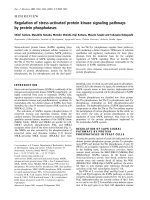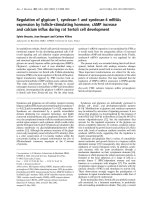Báo cáo y học: "κ Regulation of NFκB signalling during inflammation: the role of hydroxylases" potx
Bạn đang xem bản rút gọn của tài liệu. Xem và tải ngay bản đầy đủ của tài liệu tại đây (450.09 KB, 8 trang )
Available online />Page 1 of 8
(page number not for citation purposes)
Abstract
NFκB is a master regulator of innate immunity and inflammatory
signalling. Microenvironmental hypoxia has long been identified as
being coincident with chronic inflammation. The contribution of
microenvironmental hypoxia to NFκB-induced inflammation has
more recently been appreciated. Identification of the co-regulation
of NFκB and hypoxia inducible factor (HIF) pathways by 2-oxo-
glutarate-dependent hydroxylase family members has highlighted
an intimate relationship between NFκB inflammatory signalling and
HIF-mediated hypoxic signalling pathways. Adding another layer of
complexity to our understanding of the role of NFκB inflammatory
signalling by hypoxia is the recent recognition of the contribution of
basal NFκB activity to HIF-1α transcription. This observation
implicates an important and previously unappreciated role for
NFκB in inflammatory disease where HIF-1α is activated. The
present review will discuss recent literature pertaining to the
regulation of NFκB inflammatory signalling by hypoxia and some of
the inflammatory diseases where this may play an important role.
Furthermore, we will discuss the potential for prolyl-hydroxylase
inhibitors in inflammatory disease.
NF
κκ
B
The transcription factor NFκB has been investigated for its
diverse range of functions in innate immunity, stress
responses, cell survival and development. It is also the master
regulator of the inflammatory response [1]. An in-depth
review of the NFκB pathway is beyond the scope of the
present article, and there are several excellent reviews
dedicated specifically to this topic [2,3].
Briefly, the NFκB family comprises five members: p65, Rel B, c-
Rel, p50 and p52. These proteins share a highly conserved Rel
homology domain. In order to bind DNA and modulate gene
expression, family members form homodimers or heterodimers –
with the exception of Rel B, which will only form heterodimers
with p50 or p52 [4]. The most commonly encountered dimer
complex is the p50–p65 dimer [5]. There are two primary
activation pathways for NFκB: the canonical pathway, which is
predominantly dependent on inhibitor of κB kinase (IKK) beta,
and the IKKα-dependent noncanonical pathway [6].
Under resting conditions, NFκB is bound to its co-repressor
molecule IκB in the cytosol, with which it interacts through
multiple ankyrin repeats. A nuclear localisation sequence of
the p65 protein is masked and it remains predominantly
sequestered in the cytosolic compartment. Upon stimulation
IκBα is phosphorylated at serine 32 and serine 36, targeted
for ubiquitination and thereafter degraded proteolytically by
the 26S proteosome [7]. A nuclear localisation sequence of
NFκB is then revealed, and this is free to translocate and
accumulate in the nucleus where it can become transcrip-
tionally active by binding to specific κB sites within the
promoter regions of its target genes [8]. The stimulus for
IκBα to release the inhibition of NFκB has been identified as
phosphorylation by the 700 kDa IKKα/β/γ protein complex.
Genes induced by NFκB include those responsible for
encoding inflammatory genes such as TNFα, IL-1, IL-6, IL-8,
macrophage inflammatory protein 1 alpha and methyl-accept-
ing chemotaxis protein 1, cell surface adhesion molecules
such as E-selectin, vascular adhesion molecule 1 and
intracellular cell adhesion molecule 1, inducible enzymes
including cyclooxygenase 2 and inducible nitric oxide
synthase, and survival molecules such as cellular inhibitor of
apoptosis molecule 1, cellular inhibitor of apoptosis molecule
2 and BCL-X
L
[9]. A number of stimuli have been shown to
activate NFκB through the canonical pathway, including
proinflammatory cytokines, bacterial products, growth factors
Review
Hypoxia
Regulation of NF
κκ
B signalling during inflammation:
the role of hydroxylases
Kathryn M Oliver, Cormac T Taylor and Eoin P Cummins
School of Medicine and Medical Science, Conway Institute, University College Dublin, Belfield, Dublin 4, Ireland
Corresponding author: Eoin P Cummins,
Published: 23 February 2009 Arthritis Research & Therapy 2009, 11:215 (doi:10.1186/ar2575)
This article is online at />© 2009 BioMed Central Ltd
ARD = ankyrin-repeat domain; DMOG = dimethyloxallylglycine; FIH = factor-inhibiting hypoxia inducible factor; HIF = hypoxia inducible factor; IBD =
inflammatory bowel disease; IKK = inhibitor of κB kinase; IL = interleukin; NF = nuclear factor; PHD = prolyl hydroxylase; PHDI = prolyl-hydroxylase
inhibitor; RA = rheumatoid arthritis; TNBS = trinitrobenzene sulphonic acid; TNF = tumour necrosis factor; VEGF = vascular endothelial growth
factor.
Arthritis Research & Therapy Vol 11 No 1 Oliver et al.
Page 2 of 8
(page number not for citation purposes)
[10] and hypoxia [11-13]. The convergence point for these
diverse stimuli is at the level of the IKK complex. NFκB is also
activated by ultraviolet light [14,15], by oxidative stress [16],
by shear stress [17] and by other mechanisms.
NF
κκ
B, hypoxia and hydroxylases
NFκB has been shown to be activated by hypoxia in a
number of studies [12,18,19]. Cyclooxygenase 2 [20], TNFα
[21], IL-6 [22] and macrophage inflammatory protein 2 [23]
are among the target genes identified for hypoxia-induced
NFκB, and these underline the factor’s importance in
inflammatory signalling. While several groups have previously
identified hypoxia as playing a role in NFκB signalling, the
mechanism whereby a decrease in available oxygen could
elicit the activation of a transcription factor that is
predominantly activated by more traditional receptor–ligand
activation signalling pathways was unclear. While canonical
NFκB signalling is sensitive to a diverse range of ligands and
employs a plethora of signalling molecules, these signal
transduction pathways converge on the IKK complex.
We recently demonstrated a mechanism by which hypoxia
activates NFκB through IKKβ activation, leading to phos-
phorylation-dependent degradation of IκBα and activation of
NFκB. Pharmacological hydroxylase inhibition with dimethyl-
oxallylglycine (DMOG) activated NFκB signalling and defined
a repressive role for prolyl hydroxylase (PHD)-1 controlling
activity of NFκB. IKKβ expression and activity were found to
be increased by hypoxia [11]. Interestingly, IKKβ (and IKKα)
contains an evolutionarily conserved LXXLAP motif that
resembles the prolyl hydroxylation sites in hypoxia inducible
factor (HIF) alpha. In this pathway, therefore, hypoxia appears
to activate NFκB through decreased PHD-dependent
hydroxylation of IKKβ, although hydroxylation of IKKβ at
proline 191 has yet to be demonstrated. Further work on
IKKβ and the inflammatory response supports the theory that
hypoxia has the potential to modulate the NFκB response to
inflammatory stimuli through catalytic upregulation of IKKβ
[13]. See Figure 1 for a schematic of hypoxia-induced NFκB
activation.
While it has yet to be proven that IKKβ is hydroxylated by the
PHDs, they do have an important role in regulating the
stability of HIF, especially the PHD-2 isoform [24]. Hydroxyl-
ation of specific prolyl residues (proline 402 and proline 564
for human HIF-1α) regulates oxygen-dependent degradation
of HIF-1α. Under conditions of hypoxia or by direct inhibition
of the PHD enzymes, HIF-1α escapes hydroxylation and
becomes stabilised [25,26]. Furthermore, the asparaginyl
hydroxylase factor-inhibiting hypoxia inducible factor (FIH)-1
is a Fe(II)-dependent and 2-oxoglutarate-dependent dioxyge-
nase, like the PHD family members and plays a role in
regulating HIF transcriptional activity. FIH-1 was identified as
being the oxygenase catalysing hydroxylation of asparagine
803 in HIF-1α, thus preventing interaction with the p300
CH1 domain and preventing HIF transactivation [27,28].
Other FIH substrates have been identified recently, and include
members of the NFκB [29] and Notch [30,31] signalling
pathways. Cockman and colleagues discovered that both
p105 (the precursor of the p50 component of NFκB) and IκBα
are hydroxylated by FIH-1 at specific residues in their ankyrin-
repeat domains (ARDs) [29]. Treatment of the cells with
hypoxia or DMOG resulted in the repression of hydroxylation.
The inhibitory action of IκB on NFκB DNA binding was
unaffected by ARD hydroxylation, however, and the function of
ARD hydroxylation is unknown to date. Given that some ARDs
bind FIH-1 with higher affinity than the ARD of HIF-1α
, ARDs
may compete with HIF-1α for FIH-1, thus restricting the action
of FIH-1 on HIF [30,31]. The consequences of such
competition would probably be extremely complex given the
high number of ARDs in the proteome and the probable
identification of new hydroxylase substrates.
NF
κκ
B and hypoxia inducible factor cross-talk
The hypoxic response is predominantly regulated by HIF-1,
the α subunit of which is stabilised under low oxygen
conditions leading to the induction of genes to restore blood
supply and nutrients to the cell as well as allowing resumption
of energy production. Upregulation of HIF by bacterial and
viral compounds in cells of the immune system prepares the
Figure 1
Hypoxia activates NFκB signalling via inhibitor of κB kinase. Under
conditions of hypoxia, the hydroxylase-mediated repression of inhibitor
of κB kinase (IKK) beta is suppressed – leading to enhanced IKKβ
activity, enhanced IκBα phosphorylation and degradation as well as
increased p65 NFκB activity. Factor-inhibiting hypoxia inducible factor
inhibition by hypoxia or pharmacological inhibition reduces IκBα
asparaginyl hydroxylation but does not appear to affect IκBα
degradation. COX-2, cyclooxygenase 2; ICAM-1, intracellular adhesion
molecule 1; iNOS, inducible nitric oxide synthase; RANTES, regulated
upon activation normal T-cell expressed and secreted; PHD-1, prolyl
hydroxylase 1; VCAM-1, vascular cell adhesion molecule 1.
cells for migration to the hypoxic environment of inflamed and
injured tissues. Furthermore, HIF-1α is essential for myeloid cell-
mediated inflammation. Myeloid cells lacking HIF-1α had a lower
glycolytic capacity, resulting in impairments in myeloid cell
aggregation, motility, invasiveness and bacterial killing [32].
Elevated levels of HIF-1α have been found in the inflamed joints
of patients suffering from rheumatoid arthritis (RA) [33]. HIF
therefore appears to have an important role in the coordination
of cellular responses under conditions of inflammation.
A molecular link between NFκB and HIF-1α was proposed
initially in a study examining erythropoietin expression [34].
This article was followed by a number of studies from Jung
and colleagues examining the cross-talk between NFκB and
HIF-1α [35-37]. Their work reported that the inflammatory
cytokine IL-1β upregulated HIF-1α protein via an inflammatory
signalling pathway involving NFκB and cyclooxygenase 2.
This upregulation occurred under normoxic conditions but
provided the basis for future observations regarding links
between NFκB and HIF [13,38-44].
On the other hand, a positive role for HIF and NFκB inter-
action in inflammatory signalling under conditions of hypoxia
was described by Walmsley and colleagues, who investi-
gated hypoxia-induced neutrophil survival [45]. Neutrophils
are the key effectors of the innate immune system, and
hypoxia has been shown to inhibit neutrophil apoptosis.
Investigation of this phenomenon led to the discovery that
HIF-1α-dependent upregulation of NFκB p65 and IKKα
occurred in neutrophils, and this led to the conclusion that
HIF-1α-dependent NFκB signalling is of critical importance in
the hypoxic response in neutrophils [45].
The presence of an NFκB site within the HIF-1α promoter
–197/–188 base pairs upstream of the transcriptional start
site provides further evidence of the link between these two
crucially important transcription factors [39]. When this site
was mutated, induction of HIF-1α by hypoxia was lost.
Binding of NFκB p50 and p65 to the HIF-1α promoter in
response to hypoxia gave evidence that NFκB regulates
HIF-1α via a transcriptional mechanism [38].
Compelling in vivo evidence for cross-talk between NFκB
and HIF-1α comes from a recent paper by Rius and
colleagues [13]. This work directly linked NFκB, innate
immunity and the hypoxic response through studies involving
the depletion of a component of the NFκB signalling
pathway. Using mice lacking IKKβ (the key catalytic subunit in
inflammatory signalling) in a variety of cell types, NFκB was
shown to be a critical transcriptional activator of HIF-1α [13].
This evidence provides support for the concept of NFκB and
HIF-1α engaging in a positive enhancement loop under
conditions of hypoxia and inflammation. Significantly, basal
NFκB activity is required for the accumulation of HIF-1
α in
cultured cells under conditions of hypoxia as well as in the
liver and brain of hypoxic animals. IKKβ links the hypoxic
response and innate immunity since a deficiency in IKKβ
leads to ineffective induction of HIF-1α target genes,
meaning that resolution of inflammation in the injured cell is
likely to be impaired. Furthermore, defects in HIF-1α
expression are observed in mice exposed to hypoxia and to
macrophages experiencing a bacterial infection in the
absence of IKKβ [13]. A single component part of the NFκB
signalling cascade has therefore been shown to play a crucial
role in the cross-talk between the two pathways.
In another recent study, van Uden and colleagues suggest
that both catalytic subunits of the IKK complex, IKKα and
IKKβ, must be depleted for hypoxia-induced HIF-1α stabilisa-
tion to be impaired in mouse embryonic fibroblasts [44]. The
different cell types used by the groups of van Uden and of
Rius may account for the contrasting results observed. Rius
and colleagues used bone-marrow-derived macrophages
from IKKβ
–/–
mice while van Uden and colleagues used
mouse embryonic fibroblasts to inform their conclusions [13].
Interestingly, van Uden and colleagues showed that the
individual NFκB members have differential effects on HIF-1α
mRNA levels [44], illustrating another level of complexity in
this relationship. Several NFκB subunits (RelA, RelB, c-Rel,
p50, p52) were found at the HIF-1α promoter using
chromatin immunoprecipitation, indicating that the basal level
of HIF-1α mRNA is directly modulated by NFκB [44].
The signalling subtleties with respect to the individual NFκB
family proteins bound to the HIF-1α promoter have yet to be
fully elucidated. Specific reviews on the cross-talk between
HIF and NFκB at inflammatory hypoxic loci have recently
been published [46,47] and provide interesting interpre-
tations of the recent published data. While the evidence to
date does not lead to an unequivocal thesis, what is clear is
that there is significant cross-talk between HIF-1α and NFκB
transcriptional repertoires – with each being able to influence
expression of the other’s members in some cells. This is an
important consideration with respect to designing inter-
vention strategies in inflammatory disease. See Figure 2 for a
schematic of NFκB and HIF-1α cross-talk.
Hypoxia and inflammation
Hypoxia is a feature of sites of chronic inflammation, for
example in the RA synovium, in atherosclerotic plaques, in
sites of bacterial infection and at growing tumours [48]. This
occurs when the cellular demand for oxygen, in order to meet
the metabolic needs of the tissue to produce ATP, exceeds
the vascular supply. While angiogenesis is a feature of
hypoxic inflammation as well as being an adaptive response
to decreased oxygen availability, the microvascular architec-
ture is dysregulated in chronic inflammatory disease. There-
fore, while there are more capillaries to deliver oxygen to a
site of inflammation, the efficiency is poor. Furthermore, what
limited oxygen is delivered to an inflammatory locus can be
depleted further by oxygen consumption by highly meta-
bolically active resident and infiltrating cells [49].
Available online />Page 3 of 8
(page number not for citation purposes)
Rheumatoid arthritis
RA is a systemic autoimmune disorder that is characterised
by persistent inflammation of a hyperplastic synovium, which
consists of various cell types including synovial fibroblasts, B
cells, T cells and macrophages. Cartilage and bone are invaded
by the hyperplastic synovium, resulting in the progressive
destruction of these joints [50]. An hypoxic environment has
been shown to exist in RA synovium [51,52] as well as an
increase in the level of hypoxic metabolites compared with
normal synovium [53].
A number of growth factors and cytokines capable of
activating HIF-1α are known to be upregulated in RA; for
example, the NFκB target genes TNFα and IL-1β. In addition,
incubation of cultured synovial fibroblasts with IL-1β results in
stabilisation of HIF-1 [54]. Studies have shown increased
levels of HIF-1α protein in rheumatoid synovial tissues
[33,55], which has led to the hypothesis that tissue hypoxia
together with HIF-1α-mediated expression of vascular endo-
thelial growth factor (VEGF) is essential for the progression
of RA through promotion of angiogenesis [56]. Angiogenesis
provides the necessary vasculature so that migration of cells
into the joints can occur [48]. HIF also promotes arthritis
through the induction of the transcription factor Ets-1 [57].
Ets-1 is responsible for the induction of matrix metalloproteins,
which are involved in cartilage and bone destruction [58].
To date, no strong links have been demonstrated between
hypoxia-induced NFκB and RA. Hitchon and El-Gabalawy,
however, suggest that cycles of hypoxia and reoxygenation in
the arthritic joint lead to reactive oxygen species production,
which would serve as a stimulus for NFκB activation [59].
Psoriasis
Angiogenesis induced by VEGF also appears to play a crucial
role in the formation of psoriatic plaques. VEGF mRNA and
mRNA for its receptor Flt-1 are increased in psoriatic skin
compared with normal human skin [60]. Rosenberger and
colleagues present the hypothesis that physiologic regional
hypoxia occurring in the dermal glands triggers a cycle
involving HIF, VEGF and Akt activation [61]. They showed that
HIF-1α mRNA is elevated in the epidermis of psoriatic skin and
that HIFs are strongly activated in cell types that express pivotal
angiogenic factors. This led to the theory that more severe skin
hypoxia in psoriasis could lead to keratinocyte and HIF-
mediated angiogenesis through upregulation of VEGF and Flt-
1. Phospho-Akt in the dermal capillaries is thought likely to
provide positive feedback to the HIF-VEGF system [61].
Inflammatory bowel disease
Links between hypoxia, HIF-1 and NFκB signalling have been
demonstrated for chronic inflammation in murine models of
colitis. In cells of the gastrointestinal tract, the effects of
hypoxia on transepithelial permeability have been implicated
in inflammatory bowel disease (IBD), which consists of
Crohn’s disease and ulcerative colitis [21]. Both the HIF-1
and NFκB pathways have been demonstrated to have
protective roles in intestinal epithelial cells through the use of
intestinal epithelial cell conditional knockout mice for HIF-1α
and IKKβ [62-64]. Karhausen and colleagues showed that
mice constitutively expressing HIF-1α in the colon were
protected from hypoxia-induced permeability changes, as well
as from trinitrobenzene sulphonic acid (TNBS) colitis [64].
Conversely, conditional knockout of HIF-1α in the gut resulted
in more severe symptoms of colitis. Meanwhile, Greten and
colleagues demonstrated that conditional knockdown of IKK-β
in enterocytes resulted in increased apoptotic damage in a
murine model of dextran sulphate sodium-induced colitis [63].
DMOG is a pan hydroxylase inhibitor that has been shown to
activate both HIF-1α-dependent [65] and NFκB-dependent
[11] gene expression in vitro, most probably through the
inhibition of hydroxylation-dependent repression of both
signalling pathways. In a recent study we demonstrated that
DMOG is profoundly protective in a murine model of dextran
sulphate sodium colitis [66]. We hypothesised this to be via
induction of both HIF-1α and NFκB pathways, and proposed
that its occurrence was at least in part due to the
development of an anti-apoptotic phenotype. Inhibition of
apoptosis by DMOG is hypothesised to be important in the
maintenance of epithelial barrier function in murine colitis and
to prevent mixing of luminal antigens with the submucosa that
houses the mucosal immune system. Previous studies have
Arthritis Research & Therapy Vol 11 No 1 Oliver et al.
Page 4 of 8
(page number not for citation purposes)
Figure 2
NFκB and hypoxia inducible factor 1 alpha cross-talk. Hypoxia acts as a
stimulus for the activation of the inhibitor of κB kinase (IKK) complex as
shown in Figure 1. Basal IKKβ-dependent NFκB activity is required for
transcriptionally active dimer complexes to translocate to the nucleus
and bind to a region –197/188 base pairs upstream of the hypoxia
inducible factor (HIF)-1α promoter. This results in an increase in HIF-1α
mRNA and protein levels. Several NFκB proteins have been detected at
the HIF-1α promoter region by chromatin immunoprecipitation.
Increased levels of HIF-1α are observed in chronically inflamed tissue
such as the rheumatoid arthritis (RA) synovium and in the dermal glands
of psoriatic skin. FIH, factor-inhibiting hypoxia inducible factor.
suggested that the regulation of intestinal epithelial cell
apoptosis is crucial in the development of inflammation in the
gut [67,68]. Further support for the above data is provided by
Robinson and colleagues [69] who demonstrated in a TNBS-
induced murine model of colitis that induction of HIF-1α by
FG-4497 (a novel PHD inhibitor) results in beneficial out-
comes. This effect is likely due to a barrier-protective function.
Conversely, Shah and colleagues have suggested that HIF in
fact augments experimental colitis through macrophage
migration inhibitory factor-dependent signalling [70]. Their
data show that a chronic increase in HIF signalling in colon
epithelial cells results in increased expression of proinflam-
matory mediators, the levels of which were decreased by
inhibition of the HIF target gene migration inhibitory factor.
The perceived conflict between the above studies and this
one may at least in part be explained by the fact that the
proinflammatory phenotype of the VhlΔ
IE
mouse model used
by Shah and colleagues [70] was HIF-2α mediated, while the
protection observed by Karhausen and colleagues [64] was
HIF-1α mediated. This difference suggests that HIF-1α and
HIF-2α may have distinct and separate roles in colon
homeostasis. Other differences between the studies that may
have contributed to the disparity in findings include (i) the
specific promoter used to drive the intestinal epithelial cell
knockout – Karhausen and colleagues [64] used mice
expressing Cre-recombinase under the transcriptional control
of a fatty acid binding protein promoter, while Shah and
colleagues [70] used mice expressing Cre-recombinase
under the control of the villin promoter – and (ii) the model of
colitis employed – Karhausen and colleagues [64] used
TNBS-induced colitis, while Shah and colleagues [70] used
an irritant-based model of colitis.
Prolyl-hydroxylase inhibitors in inflammatory
disease
The use and development of prolyl-hydroxylase inhibitors
(PHDIs) in the treatment of disease is an area of intense
research. Several recent studies have reported the potential
for using PHDIs in animal models of ischaemia affecting the
whole animal [71], the brain [72], the heart [73] and the
kidney [74-76] as well as in IBD [66,69].
The difficulty in developing specific PHDIs suitable for use in
the clinic centres on the current lack of specificity of PHDIs
as well as isoform-specific roles for the different PHDs. Most
available PHDIs act at the substrate binding interface and
interfere with the PHD interaction with essential co-factors
(2-oxoglutarate, Fe2
+
, ascorbate). Structural mimetics of 2-
oxoglutarate are amongst the most commonly used but other
nonspecific compounds such as desferrioxamine and cobalt
interfere with the iron/ascorbate balance. 2-Oxoglutarate
analogues are essentially pan-hydroxylase inhibitors and
inhibit prolyl and asparaginyl hydroxylases alike. Evidence
from PHD3
–/–
mice suggests a neuronal role for PHD3 in
sympathoadrenal development [77]. Evidence from PHD1
–/–
mice suggests a role for PHD1 in the regulation of basal
metabolism [78]. PHD2
–/–
mice are embryonic lethal [79].
Against this background, systemic administration of pan-
hydroxylase inhibitors may be undesirable given the diverse
functions of the individual PHD isoforms. Development of
specific PHDIs will probably advance their potential as
therapies in the future.
Development of specific PHDIs may be of particular use in
the treatment of inflammatory disease, where recent studies
using the PHDIs DMOG and FG-4497 resulted in profound
protection from experimentally induced colitis in mice. In a
study using dextran sulphate sodium-induced colitis, intra-
peritoneal injection of DMOG significantly reduced the
development of colitis [66]. Using the PHDI FG-4497,
Robinson and colleagues demonstrated similar protection in
their model of TNBS-induced colitis [69]. Future work is
needed to determine the specific hydroxylase isoform target
of the drugs in vivo or, indeed, whether the protective effect
from colitis is only evident against a background of pan-
hydroxylase inhibition. Similarly, the downstream effectors of
hydroxylase inhibition that occasion the protection from colitis
need to be fully elucidated. Studying the development of
experimental colitis in isoform-specific PHD null mice will
greatly enhance our understanding of the role of hydroxylases
as possible therapeutic targets in inflammatory disease.
The colon is ideally suited to avail of the benefits of PHDI in
inflammatory disease. HIF-1α activation under conditions of
hypoxia is known to activate a number of epithelial barrier-
protective genes [49]. Maintenance of intestinal epithelial
barrier integrity is of paramount importance in IBD such as
ulcerative colitis and Crohn’s disease. An intact epithelial
barrier will prevent luminal antigenic material mixing inappro-
priately with the submucosa and will prevent inflammation.
Targeted delivery of a PHDI that can activate NFκB and HIF
at the beginning of an IBD episode may therefore prove
beneficial through maintenance of barrier integrity via IKKβ-
mediated suppression of enterocyte apoptosis [63] and
HIF-1α-mediated barrier protection [64]. The use of PHDIs in
inflammatory conditions, however, should be approached
with caution. Activating NFκB via PHD inhibition – whilst
potentially beneficial in the suppression of apoptosis and
maintenance of epithelial barrier protection – could lead to
inappropriate survival of cancer cells. Similarly, the addition of
an NFκB-activating PHDI in an inflammatory setting may
seem counterintuitive given the body of evidence for NFκB
target genes contributing to inflammatory signalling [80,81].
The targeted delivery of a PHDI in the appropriate inflamma-
tory condition will therefore be of paramount importance.
Activation of HIF in inflammatory disease via PHDIs also
comes with caveats. While one subset of HIF target genes
actively maintains the epithelial barrier as discussed
previously, another subset of HIF-1-dependent proangiogenic
genes may also be activated. This could potentially contribute
Available online />Page 5 of 8
(page number not for citation purposes)
to localised angiogenesis and may increase the risk of
inflammation-associated cancer.
As a consequence, PHDIs may not be indicated in RA
because of the central contribution of angiogenesis in the
pathogenesis and invasiveness of that particular inflammatory
condition. Similarly, the contribution of angiogenesis to the
development of psoriatic plaques may preclude the use of
PHDIs. The use of PHDIs in IBD does, however, show some
promise. The profound protection from experimentally
induced colitis seen with DMOG [66] and with FG-4497
[69], coupled with the pre-eminent role of the intestinal
epithelial cell in preventing inflammation, makes the use of
PHDIs an attractive potential therapeutic strategy in IBD.
Conclusions
Identification of the co-regulation of NFκB and HIF pathways
by hydroxylase family members has enhanced our under-
standing of the mechanism of hypoxia-induced NFκB activity.
The fact that the inhibitory action of hydroxylases is at the
level of the IKK complex through suppression of catalytic
activity means that microenvironmental hypoxia has the
potential to modulate NFκB signalling elicited through a
range of stimuli such as TNFα. The implication of such NFκB-
inducing stimuli in the initiation of HIF-1α transcription
highlights the importance of hypoxia and NFκB together and
in isolation in the inflammatory response. The complicated
cross-talk between these two signalling pathways means that
even specific inhibitors of NFκB and HIF are likely to
influence the other pathway. Notwithstanding this, exciting
new evidence is emerging for the potential therapeutic
application of hydroxylase inhibitors in a range of ischaemic
conditions affecting the whole animal [71], the brain [72], the
heart [73] and the kidney [74-76], and also in models of
hypoxic inflammation such as IBD [66,69].
Competing interests
The authors declare that they have no competing interests.
Authors’ information
Owing to space restrictions, it was not possible in the
present article to reference every publication relevant to the
role of hydroxylases in NFκB signalling.
Acknowledgements
The authors are funded by the Science Foundation Ireland (CTT and
EPC) and by the Health Research Board (Ireland) (KMO)
References
1. Chen LF, Greene WC: Shaping the nuclear action of NF-
κκ
B.
Nat Rev Mol Cell Biol 2004, 5:392-401.
2. Hayden MS, Ghosh S: Shared principles in NF-
κκ
B signaling.
Cell 2008, 132:344-362.
3. Karin M: The I
κκ
B kinase – a bridge between inflammation and
cancer. Cell Res 2008, 18:334-342.
4. Ryseck RP, Bull P, Takamiya M, Bours V, Siebenlist U, Dobrzanski
P, Bravo R: RelB, a new Rel family transcription activator that
can interact with p50-NF-
κκ
B. Mol Cell Biol 1992, 12:674-684.
5. Chen YQ, Sengchanthalangsy LL, Hackett A, Ghosh G: NF-
κκ
B
p65 (RelA) homodimer uses distinct mechanisms to recog-
nize DNA targets. Structure 2000, 8:419-428.
6. Van Waes C, Yu M, Nottingham L, Karin M: Inhibitor-
κκ
B kinase
in tumor promotion and suppression during progression of
squamous cell carcinoma. Clin Cancer Res 2007, 13:4956-
4959.
7. Chen ZJ, Parent L, Maniatis T: Site-specific phosphorylation of
I
κκ
B
αα
by a novel ubiquitination-dependent protein kinase
activity. Cell 1996, 84:853-862.
8. Chen FE, Huang DB, Chen YQ, Ghosh G: Crystal structure of
p50/p65 heterodimer of transcription factor NF-
κκ
B bound to
DNA. Nature 1998, 391:410-413.
9. Pahl HL: Activators and target genes of Rel/NF-
κκ
B transcrip-
tion factors. Oncogene 1999, 18:6853-6866.
10. Moynagh PN: The NF-
κκ
B pathway. J Cell Sci 2005, 118(Pt 20):
4589-4592.
11. Cummins EP, Berra E, Comerford KM, Fitzgerald KT, Seeballuck
F, Godson C, Nielsen JE, Moynagh P, Pouyssegur J, Taylor CT:
Prolyl hydroxylase-1 negatively regulates IkB kinase-
ββ
giving
insight into hypoxia-induced NFkB activity. Proc Natl Acad Sci
U S A 2006, 103:18154-18159.
12. Koong AC, Chen EY, Giaccia AJ: Hypoxia causes the activation
of nuclear factor
κκ
B through the phosphorylation of I
κκ
B
αα
on
tyrosine residues. Cancer Res 1994, 54:1425-1430.
13. Rius J, Guma M, Schachtrup C, Akassoglou K, Zinkernagel AS,
Nizet V, Johnson RS, Haddad GG, Karin M: NF-
κκ
B links innate
immunity to the hypoxic response through transcriptional reg-
ulation of HIF-1
αα
. Nature 2008, 453:807-811.
14. Li N, Karin M: Ionizing radiation and short wavelength UV acti-
vate NF-
κκ
B through two distinct mechanisms. Proc Natl Acad
Sci U S A 1998, 95:13012-13017.
15. O’Dea EL, Kearns JD, Hoffmann A: UV as an amplifier rather
than inducer of NF-
κκ
B activity. Mol Cell 2008, 30:632-641.
16. Schmidt KN, Amstad P, Cerutti P, Baeuerle PA: The roles of
hydrogen peroxide and superoxide as messengers in the
activation of transcription factor NF-
κκ
B. Chem Biol 1995, 2:13-
22.
17. Khachigian LM, Resnick N, Gimbrone MA, Jr, Collins T: Nuclear
factor-
κκ
B interacts functionally with the platelet-derived
growth factor B-chain shear-stress response element in vas-
cular endothelial cells exposed to fluid shear stress. J Clin
Invest 1995, 96:1169-1175.
18. Leeper-Woodford SK, Detmer K: Acute hypoxia increases alve-
olar macrophage tumor necrosis factor activity and alters
NF-
κκ
B expression. Am J Physiol 1999, 276(6 Pt 1):L909-L916.
19. Chandel NS, Trzyna WC, McClintock DS, Schumacker PT: Role
of oxidants in NF-
κκ
B activation and TNF-
αα
gene transcription
induced by hypoxia and endotoxin. J Immunol 2000, 165:1013-
1021.
20. Schmedtje JF, Jr, Ji YS, Liu WL, DuBois RN, Runge MS: Hypoxia
induces cyclooxygenase-2 via the NF-
κκ
B p65 transcription
factor in human vascular endothelial cells. J Biol Chem 1997,
272:601-608.
21. Taylor CT, Dzus AL, Colgan SP: Autocrine regulation of epithe-
lial permeability by hypoxia: role for polarized release of
tumor necrosis factor
αα
. Gastroenterology 1998, 114:657-668.
22. Matsui H, Ihara Y, Fujio Y, Kunisada K, Akira S, Kishimoto T,
Yamauchi-Takihara K: Induction of interleukin (IL)-6 by hypoxia
is mediated by nuclear factor (NF)-
κκ
B and NF-IL6 in cardiac
myocytes. Cardiovasc Res 1999, 42:104-112.
23. Zampetaki A, Mitsialis SA, Pfeilschifter J, Kourembanas S:
Hypoxia induces macrophage inflammatory protein-2 (MIP-2)
gene expression in murine macrophages via NF-
κκ
B: the
prominent role of p42/p44 and PI3 kinase pathways. FASEB J
2004, 18:1090-1092.
24. Berra E, Benizri E, Ginouves A, Volmat V, Roux D, Pouyssegur J:
Arthritis Research & Therapy Vol 11 No 1 Oliver et al.
Page 6 of 8
(page number not for citation purposes)
This review is part of a series on
Hypoxia
edited by Ewa Paleolog.
Other articles in this series can be found at
/>review-series.asp?series=ar_hypoxia
HIF prolyl-hydroxylase 2 is the key oxygen sensor setting low
steady-state levels of HIF-1
αα
in normoxia. EMBO J 2003,
22:4082-4090.
25. Ivan M, Kondo K, Yang H, Kim W, Valiando J, Ohh M, Salic A,
Asara JM, Lane WS, Kaelin WG, Jr: HIF
αα
targeted for VHL-
mediated destruction by proline hydroxylation: implications
for O
2
sensing. Science 2001, 292:464-468.
26. Jaakkola P, Mole DR, Tian YM, Wilson MI, Gielbert J, Gaskell SJ,
Kriegsheim A, Hebestreit HF, Mukherji M, Schofield CJ, Maxwell
PH, Pugh CW, Ratcliffe PJ: Targeting of HIF-
αα
to the von
Hippel–Lindau ubiquitylation complex by O
2
-regulated prolyl
hydroxylation. Science 2001, 292:468-472.
27. Hewitson KS, McNeill LA, Riordan MV, Tian YM, Bullock AN,
Welford RW, Elkins JM, Oldham NJ, Bhattacharya S, Gleadle JM,
Ratcliffe PJ, Pugh CW, Schofield CJ: Hypoxia-inducible factor
(HIF) asparagine hydroxylase is identical to factor inhibiting
HIF (FIH) and is related to the cupin structural family. J Biol
Chem 2002, 277:26351-26355.
28. Lando D, Peet DJ, Gorman JJ, Whelan DA, Whitelaw ML, Bruick
RK: FIH-1 is an asparaginyl hydroxylase enzyme that regu-
lates the transcriptional activity of hypoxia-inducible factor.
Genes Dev 2002, 16:1466-1471.
29. Cockman ME, Lancaster DE, Stolze IP, Hewitson KS, McDo-
nough MA, Coleman ML, Coles CH, Yu X, Hay RT, Ley SC, Pugh
CW, Oldham NJ, Masson N, Schofield CJ, Ratcliffe PJ: Post-
translational hydroxylation of ankyrin repeats in I
κκ
B proteins
by the hypoxia-inducible factor (HIF) asparaginyl hydroxylase,
factor inhibiting HIF (FIH). Proc Natl Acad Sci U S A 2006, 103:
14767-14772.
30. Coleman ML, McDonough MA, Hewitson KS, Coles C, Mecinovic
J, Edelmann M, Cook KM, Cockman ME, Lancaster DE, Kessler
BM, Oldham NJ, Ratcliffe PJ, Schofield CJ: Asparaginyl hydroxy-
lation of the Notch ankyrin repeat domain by factor inhibiting
hypoxia-inducible factor. J Biol Chem 2007, 282:24027-24038.
31. Zheng X, Linke S, Dias JM, Zheng X, Gradin K, Wallis TP, Hamil-
ton BR, Gustafsson M, Ruas JL, Wilkins S, Bilton RL, Brismar K,
Whitelaw ML, Pereira T, Gorman JJ, Ericson J, Peet DJ, Lendahl U,
Poellinger L: Interaction with factor inhibiting HIF-1 defines an
additional mode of cross-coupling between the Notch and
hypoxia signaling pathways. Proc Natl Acad Sci U S A 2008,
105:3368-3373.
32. Cramer T, Yamanishi Y, Clausen BE, Forster I, Pawlinski R,
Mackman N, Haase VH, Jaenisch R, Corr M, Nizet V, Firestein GS,
Gerber HP, Ferrara N, Johnson RS: HIF-1
αα
is essential for
myeloid cell-mediated inflammation. Cell 2003, 112:645-657.
33. Hollander AP, Corke KP, Freemont AJ, Lewis CE: Expression of
hypoxia-inducible factor 1
αα
by macrophages in the rheuma-
toid synovium: implications for targeting of therapeutic genes
to the inflamed joint. Arthritis Rheum 2001, 44:1540-1544.
34. Figueroa YG, Chan AK, Ibrahim R, Tang Y, Burow ME, Alam J,
Scandurro AB, Beckman BS: NF-
κκ
B plays a key role in
hypoxia-inducible factor-1-regulated erythropoietin gene
expression. Exp Hematol 2002, 30:1419-1427.
35. Jung Y, Isaacs JS, Lee S, Trepel J, Liu ZG, Neckers L: Hypoxia-
inducible factor induction by tumour necrosis factor in nor-
moxic cells requires receptor-interacting protein-dependent
nuclear factor
κκ
B activation. Biochem J 2003, 370(Pt 3):1011-
1017.
36. Jung YJ, Isaacs JS, Lee S, Trepel J, Neckers L: IL-1
ββ
-mediated
up-regulation of HIF-1
αα
via an NF
κκ
B/COX-2 pathway identi-
fies HIF-1 as a critical link between inflammation and oncoge-
nesis. FASEB J 2003, 17:2115-2117.
37. Jung YJ, Isaacs JS, Lee S, Trepel J, Neckers L: Microtubule
disruption utilizes an NF
κκ
B-dependent pathway to stabilize
HIF-1
αα
protein. J Biol Chem 2003, 278:7445-7452.
38. Belaiba RS, Bonello S, Zahringer C, Schmidt S, Hess J, Kietz-
mann T, Gorlach A: Hypoxia up-regulates hypoxia-inducible
factor-1
αα
transcription by involving phosphatidylinositol 3-
kinase and nuclear factor
κκ
B in pulmonary artery smooth
muscle cells. Mol Biol Cell 2007, 18:4691-4697.
39. Bonello S, Zahringer C, BelAiba RS, Djordjevic T, Hess J, Michiels
C, Kietzmann T, Gorlach A: Reactive oxygen species activate
the HIF-1
αα
promoter via a functional NF
κκ
B site. Arterioscler
Thromb Vasc Biol 2007, 27:755-761.
40. Frede S, Stockmann C, Freitag P, Fandrey J: Bacterial lipo-
polysaccharide induces HIF-1 activation in human monocytes
via p44/42 MAPK and NF-
κκ
B. Biochem J 2006, 396:517-527.
41. Kim J, Shao Y, Kim SY, Kim S, Song HK, Jeon JH, Suh HW,
Chung JW, Yoon SR, Kim YS, Choi I: Hypoxia-induced IL-18
increases hypoxia-inducible factor-1
αα
expression through a
Rac1-dependent NF-
κκ
B pathway. Mol Biol Cell 2008, 19:433-
444.
42. Sun HL, Liu YN, Huang YT, Pan SL, Huang DY, Guh JH, Lee FY,
Kuo SC, Teng CM: YC-1 inhibits HIF-1 expression in prostate
cancer cells: contribution of Akt/NF-
κκ
B signaling to HIF-1
αα
accumulation during hypoxia. Oncogene 2007, 26:3941-3951.
43. Tacchini L, De Ponti C, Matteucci E, Follis R, Desiderio MA:
Hepatocyte growth factor-activated NF-
κκ
B regulates HIF-1
activity and ODC expression, implicated in survival, differently
in different carcinoma cell lines. Carcinogenesis 2004, 25:
2089-2100.
44. van Uden P, Kenneth NS, Rocha S: Regulation of hypoxia-
inducible factor-1
αα
by NF-
κκ
B. Biochem J 2008, 412:477-484.
45. Walmsley SR, Print C, Farahi N, Peyssonnaux C, Johnson RS,
Cramer T, Sobolewski A, Condliffe AM, Cowburn AS, Johnson N,
Chilvers ER: Hypoxia-induced neutrophil survival is mediated
by HIF-1
αα
-dependent NF-
κκ
B activity. J Exp Med 2005,
201:105-115.
46. Taylor CT: Interdependent roles for hypoxia inducible factor
and nuclear factor-
κκ
B in hypoxic inflammation. J Physiol 2008,
586(Pt 17):4055-4059.
47. Gorlach A, Bonello S: The cross-talk between NF-
κκ
B and HIF-1:
further evidence for a significant liaison. Biochem J 2008, 412:
e17-e19.
48. Murdoch C, Muthana M, Lewis CE: Hypoxia regulates
macrophage functions in inflammation. J Immunol 2005, 175:
6257-6263.
49. Taylor CT, Colgan SP: Hypoxia and gastrointestinal disease.
J Mol Med 2007, 85:1295-1300.
50. Distler O, Muller-Ladner U, Scholmerich J, Gay RE, Gay S:
Rheumatoid arthritis: new molecular and cellular aspects.
Med Klin (Munich) 1999, 94:673-680.
51. FitzGerald O, Soden M, Yanni G, Robinson R, Bresnihan B: Mor-
phometric analysis of blood vessels in synovial membranes
obtained from clinically affected and unaffected knee joints of
patients with rheumatoid arthritis. Ann Rheum Dis 1991, 50:
792-796.
52. Paleolog EM: Angiogenesis in rheumatoid arthritis. Arthritis
Res 2002, 4(Suppl 3):S81-S90.
53. Bodamyali T, Stevens CR, Billingham ME, Ohta S, Blake DR:
Influence of hypoxia in inflammatory synovitis. Ann Rheum Dis
1998, 57:703-710.
54. Thornton RD, Lane P, Borghaei RC, Pease EA, Caro J, Mochan E:
Interleukin 1 induces hypoxia-inducible factor 1 in human
gingival and synovial fibroblasts. Biochem J 2000, 350(Pt 1):
307-312.
55. Makino Y, Nakamura H, Ikeda E, Ohnuma K, Yamauchi K, Yabe Y,
Poellinger L, Okada Y, Morimoto C, Tanaka H: Hypoxia-inducible
factor regulates survival of antigen receptor-driven T cells.
J Immunol 2003, 171:6534-6540.
56. Ikeda E: Cellular response to tissue hypoxia and its involve-
ment in disease progression. Pathol Int 2005, 55:603-610.
57. Oikawa M, Abe M, Kurosawa H, Hida W, Shirato K, Sato Y:
Hypoxia induces transcription factor ETS-1 via the activity of
hypoxia-inducible factor-1. Biochem Biophys Res Commun
2001, 289:39-43.
58. Wernert N, Gilles F, Fafeur V, Bouali F, Raes MB, Pyke C, Dupres-
soir T, Seitz G, Vandenbunder B, Stehelin D: Stromal expression
of c-Ets1 transcription factor correlates with tumor invasion.
Cancer Res 1994, 54:5683-5688.
59. Hitchon CA, El-Gabalawy HS: Oxidation in rheumatoid arthritis.
Arthritis Res Ther 2004, 6:265-278.
60. Detmar M, Brown LF, Claffey KP, Yeo KT, Kocher O, Jackman
RW, Berse B, Dvorak HF: Overexpression of vascular perme-
ability factor/vascular endothelial growth factor and its recep-
tors in psoriasis. J Exp Med 1994, 180:1141-1146.
61. Rosenberger C, Solovan C, Rosenberger AD, Jinping L, Treudler
R, Frei U, Eckardt KU, Brown LF: Upregulation of hypoxia-
inducible factors in normal and psoriatic skin. J Invest Derma-
tol 2007, 127:2445-2452.
62. Chen LW, Egan L, Li ZW, Greten FR, Kagnoff MF, Karin M: The
two faces of IKK and NF-
κκ
B inhibition: prevention of systemic
inflammation but increased local injury following intestinal
ischemia-reperfusion. Nat Med 2003, 9:575-581.
Available online />Page 7 of 8
(page number not for citation purposes)
63. Greten FR, Eckmann L, Greten TF, Park JM, Li ZW, Egan LJ,
Kagnoff MF, Karin M: IKK
ββ
links inflammation and tumorigene-
sis in a mouse model of colitis-associated cancer. Cell 2004,
118:285-296.
64. Karhausen J, Furuta GT, Tomaszewski JE, Johnson RS, Colgan SP,
Haase VH: Epithelial hypoxia-inducible factor-1 is protective in
murine experimental colitis. J Clin Invest 2004, 114:1098-1106.
65. Elvidge GP, Glenny L, Appelhoff RJ, Ratcliffe PJ, Ragoussis J,
Gleadle JM: Concordant regulation of gene expression by
hypoxia and 2-oxoglutarate-dependent dioxygenase inhibi-
tion: the role of HIF-1
αα
, HIF-2
αα
, and other pathways. J Biol
Chem 2006, 281:15215-15226.
66. Cummins EP, Seeballuck F, Keely SJ, Mangan NE, Callanan JJ,
Fallon PG, Taylor CT: The hydroxylase inhibitor dimethyloxalyl-
glycine is protective in a murine model of colitis. Gastro-
enterology 2008, 134:156-165.
67. Assi K, Pillai R, Gomez-Munoz A, Owen D, Salh B: The specific
JNK inhibitor SP600125 targets tumour necrosis factor-
αα
pro-
duction and epithelial cell apoptosis in acute murine colitis.
Immunology 2006, 118:112-121.
68. Lugering A, Lebiedz P, Koch S, Kucharzik T: Apoptosis as a ther-
apeutic tool in IBD? Ann N Y Acad Sci 2006, 1072:62-77.
69. Robinson A, Keely S, Karhausen J, Gerich ME, Furuta GT, Colgan
SP: Mucosal protection by hypoxia-inducible factor prolyl
hydroxylase inhibition. Gastroenterology 2008, 134:145-155.
70. Shah YM, Ito S, Morimura K, Chen C, Yim SH, Haase VH, Gonza-
lez FJ: Hypoxia-inducible factor augments experimental colitis
through an MIF-dependent inflammatory signaling cascade.
Gastroenterology 2008, 134:2036-2048.
71. Kasiganesan H, Sridharan V, Wright G: Prolyl hydroxylase
inhibitor treatment confers whole-animal hypoxia tolerance.
Acta Physiol (Oxf) 2007, 190:163-169.
72. Nangaku M, Izuhara Y, Takizawa S, Yamashita T, Fujii-Kuriyama Y,
Ohneda O, Yamamoto M, van Ypersele de Strihou C, Hirayama N,
Miyata T: A novel class of prolyl hydroxylase inhibitors induces
angiogenesis and exerts organ protection against ischemia.
Arterioscler Thromb Vasc Biol 2007, 27:2548-2554.
73. Natarajan R, Salloum FN, Fisher BJ, Ownby ED, Kukreja RC,
Fowler AA, 3rd: Activation of hypoxia-inducible factor-1 via
prolyl-4 hydoxylase-2 gene silencing attenuates acute inflam-
matory responses in postischemic myocardium. Am J Physiol
Heart Circ Physiol 2007, 293:H1571-H1580.
74. Bernhardt WM, Campean V, Kany S, Jurgensen JS, Weidemann
A, Warnecke C, Arend M, Klaus S, Gunzler V, Amann K, Willam
C, Wiesener MS, Eckardt KU: Preconditional activation of
hypoxia-inducible factors ameliorates ischemic acute renal
failure. J Am Soc Nephrol 2006, 17:1970-1978.
75. Hill P, Shukla D, Tran MG, Aragones J, Cook HT, Carmeliet P,
Maxwell PH: Inhibition of hypoxia inducible factor hydroxy-
lases protects against renal ischemia-reperfusion injury. J Am
Soc Nephrol 2008, 19:39-46.
76. Rosenberger C, Rosen S, Shina A, Frei U, Eckardt KU, Flippin LA,
Arend M, Klaus SJ, Heyman SN: Activation of hypoxia inducible
factors (HIF) ameliorates hypoxic distal tubular injury in the
isolated perfused rat kidney. Nephrol Dial Transplant 2008,
28:831-839.
77. Bishop T, Gallagher D, Pascual A, Lygate CA, de Bono JP,
Nicholls LG, Ortega-Saenz P, Oster H, Wijeyekoon B, Sutherland
AI, Grosfeld A, Aragones J, Schneider M, van Geyte K, Teixeira D,
Diez-Juan A, Lopez-Barneo J, Channon KM, Maxwell PH, Pugh
CW, Davies AM, Carmeliet P, Ratcliffe PJ: Abnormal sympa-
thoadrenal development and systemic hypotension in
PHD3
–/–
mice. Mol Cell Biol 2008, 28:3386-3400.
78. Aragones J, Schneider M, Van Geyte K, Fraisl P, Dresselaers T,
Mazzone M, Dirkx R, Zacchigna S, Lemieux H, Jeoung NH, Lam-
brechts D, Bishop T, Lafuste P, Diez-Juan A, Harten SK, Van Noten
P, De Bock K, Willam C, Tjwa M, Grosfeld A, Navet R, Moons L,
Vandendriessche T, Deroose C, Wijeyekoon B, Nuyts J, Jordan B,
Silasi-Mansat R, Lupu F, Dewerchin M, Pugh C, Salmon P, Mortel-
mans L, Gallez B, Gorus F, Buyse J, Sluse F, Harris RA, Gnaiger E,
Hespel P, Van Hecke P, Schuit F, Van Veldhoven P, Ratcliffe P,
Baes M, Maxwell P, Carmeliet P: Deficiency or inhibition of
oxygen sensor Phd1 induces hypoxia tolerance by reprogram-
ming basal metabolism. Nat Genet 2008, 40:170-180.
79. Takeda K, Ho VC, Takeda H, Duan LJ, Nagy A, Fong GH: Placen-
tal but not heart defects are associated with elevated
hypoxia-inducible factor
αα
levels in mice lacking prolyl
hydroxylase domain protein 2. Mol Cell Biol 2006, 26:8336-
8346.
80. Holtmann MH, Neurath MF: Differential TNF-signaling in chronic
inflammatory disorders. Curr Mol Med 2004, 4:439-444.
81. Pallone F, Monteleone G: Mechanisms of tissue damage in
inflammatory bowel disease. Curr Opin Gastroenterol 2001,
17:307-312.
Arthritis Research & Therapy Vol 11 No 1 Oliver et al.
Page 8 of 8
(page number not for citation purposes)
